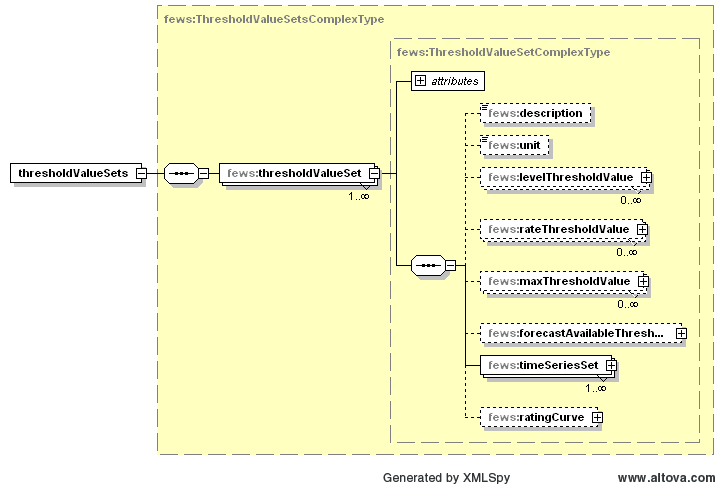...
Complementary to the definition of the types of thresholds identified, the values of the thresholds are defined in the ThresholdValueSets configuration (ThresholdValueSets.xml on a local filesystem). The configuration of this is similar to the validation rules. Several thresholds may be defined per time series. For each time series to be tested, a set of thresholds is defined.
A thresholdValueSet is build up out of:
- The values and what type each value is
- (Optional) Stage/Discharge conversions
- The timeSeries a thresholdValueSet is associated with
When thresholds are crossed, a log entry will be made. It is common practice to use this logging to initiate an Thresholds may be defined to initiate an action by the Master Controller when applied using thresholds in a live forecasting system. Actions are taken in response to a log event code. To identify which threshold crossing for which locations will initiate actions (e.g. enhanced forecasting), an event code can be defined in the ThresholdValueSet. When the threshold is crossed the event code is generated.
When available on the file system, the name of the XML file for configuring the ThresholdValueSets is for example:
ThresholdValueSets 1.00 default.xml
ThresholdValueSets Fixed file name for the ThresholdValueSets configuration
1.00 Version number
EventTypeIds (otherwise known as EventCodes) are used as a prefix in logging messages for the MC to identify which threshold is crossed.
What are the different value types?
There are 3 types of thresholdValues:
- levelThresholdValues
- rateThresholdValues
- maxThresholdValues (also known as peakThresholdValues)
levelThresholdValues are compared with single values from a timeSeries. It is crossed if a timeSeries value is bigger and the previous timeSeries value is smaller then the levelThresholdValue. i.a.w. the first time a timeSeries value is bigger. This means that the values in the timeSeries will first have to become smaller then the levelThresholdValues before it can be crossed again. Even tho the name "level" is asociated with water levels, it can be used for any parameter type (i.e. temperature, rainfall, wind).
rateThresholdValues are compared with a rate of change. To calculate this, each value in a timeSeries is matched with a value in the future that is exactly "timespan" away. The threshold is crossed if the difference between these two values is greater then the rateThresholdValue.
maxThresholdValues are compared with single values from a timeSeries. But only peak values are considered. A peak value has a previous and next value that are both lower. The threshold is crossed if a peak value is above the maxThresholdValue. If two crossings are within the timeSpan, only the first crossing will actually occurdefault Flag to indicate the version is the default configuration (otherwise omitted).
Figure 39 Elements of the ThresholdValueSets configuration.
...
Value of the threshold.
valueFunction
Function alternatives may also be used instead of the value itself (see: Location and attributes defined in Shape-DBF files).
upActionLogEventTypeId
Event code to be generated on the up-crossing of the threshold. This event code can be used to initiate for example enhanced forecasting. The event code need not be unique. Multiple threshold crossings may generate the same event code. Note that event codes will only be generated for runs which have an a-priori approved status. This is normally the scheduled forecast run.
...
